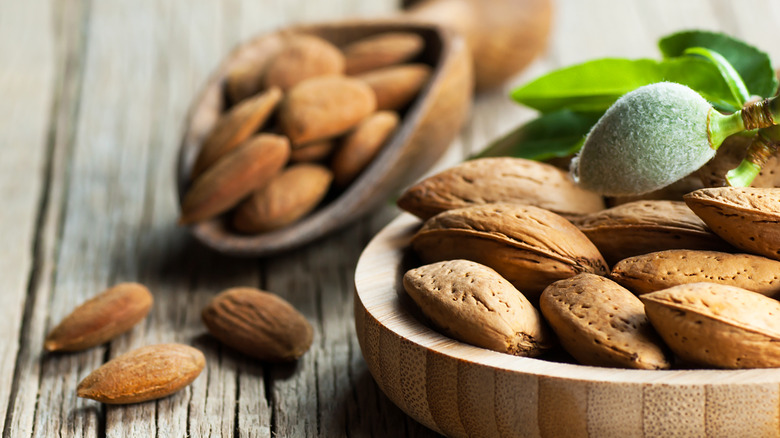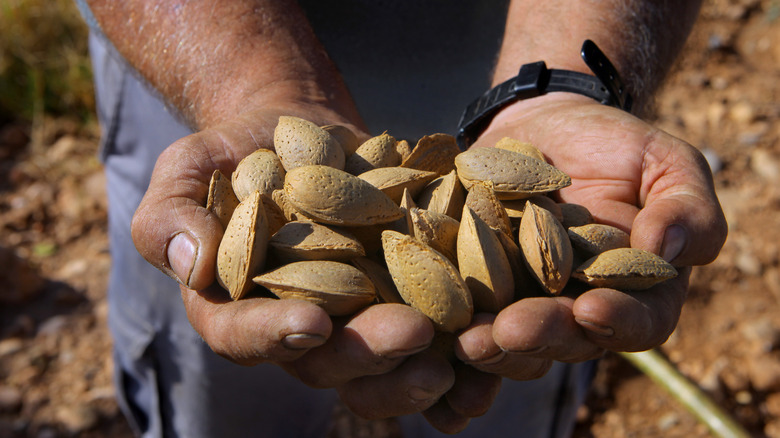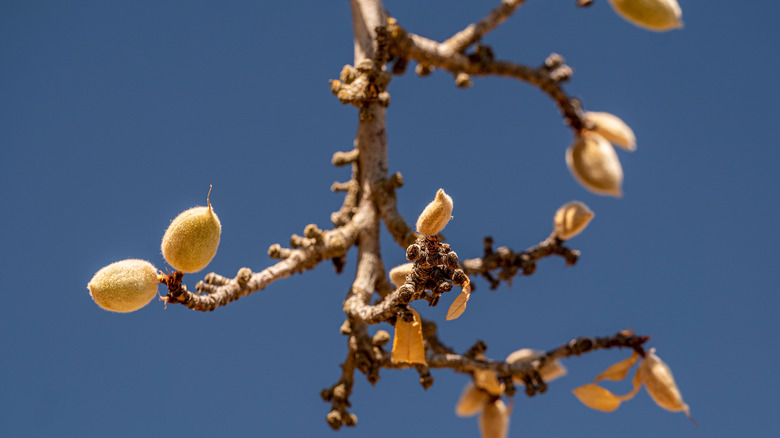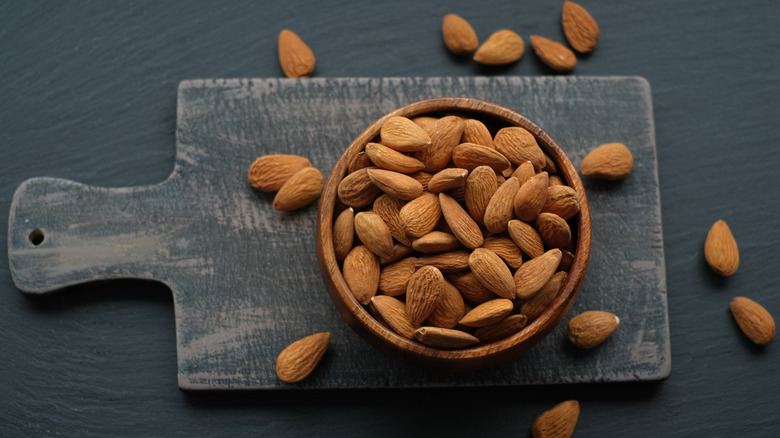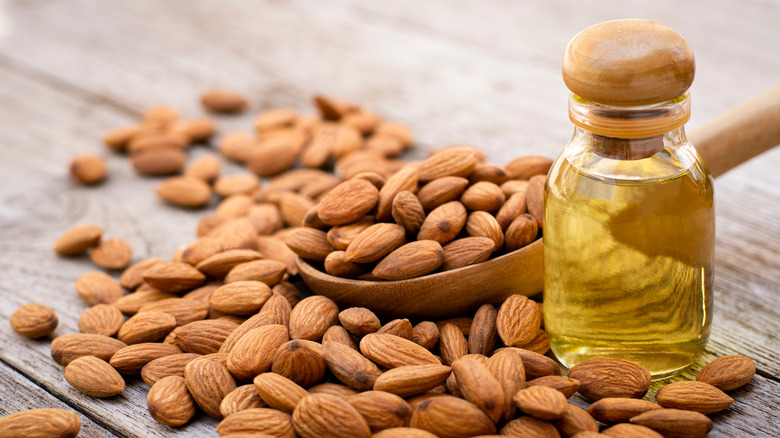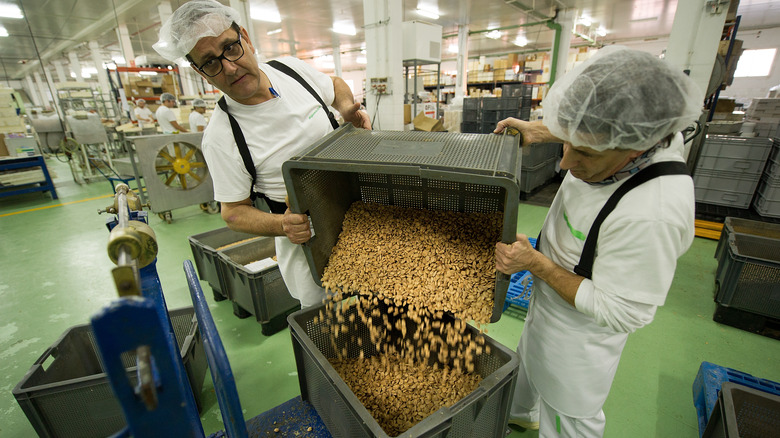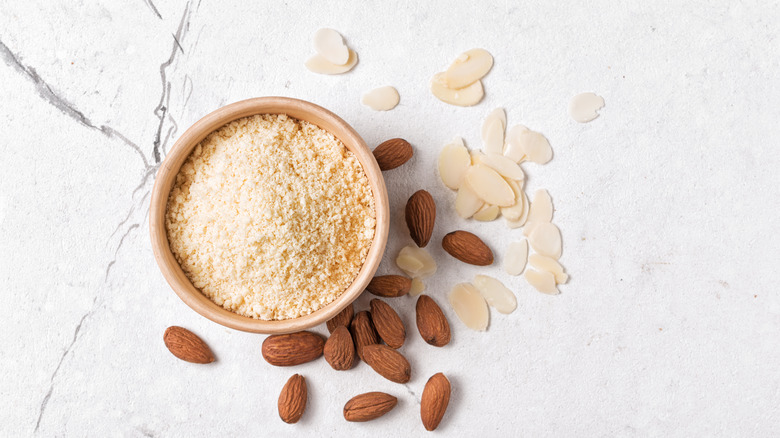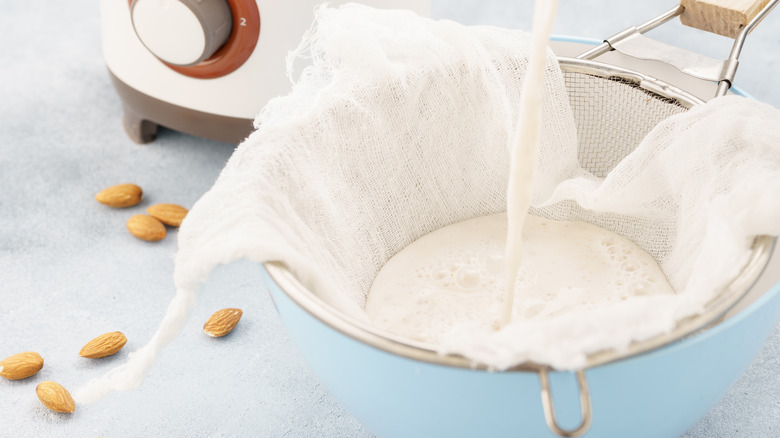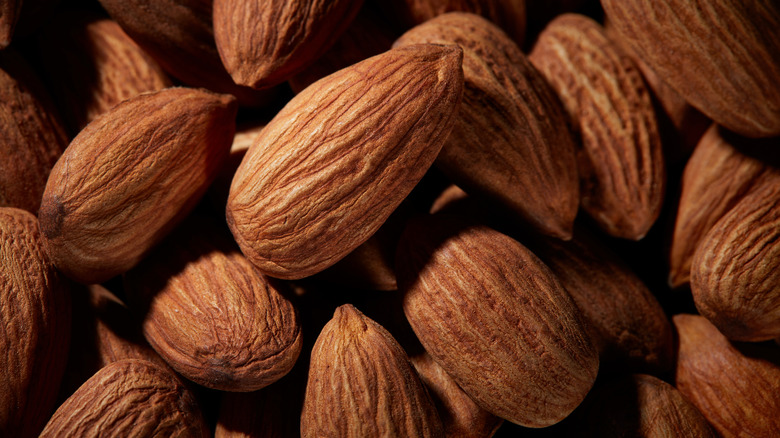Everything You Need To Know About Almonds
Consider the almond. Increasingly, shoppers tend to identify the nut with butters, flours, soaps, milks, shampoos, and desserts. It epitomizes the idea of decadence when transformed into marzipan, and evokes images of positive nutrition, thanks to its status as an alternative to dairy. This food has made a major impact on world cuisine and culture with an even greater legacy.
The almond's popularity dates back to antiquity — the food emerged from the depths of history and bloomed into a continuously-growing global market (via Knowledge Sourcing Intelligence). The near-future of the almond-producing industry looks bright too. Mordor Intelligence projects a corporate annual growth rate for the almond market of 4.5% between now and 2026. Yet, its long-term future remains uncertain due to a variety of environmental factors. The desire for almonds has the potential to take this iconic ingredient to new heights and more locales.
What are almonds?
According to Encyclopedia Britannica, almonds originated in southwestern Asia, while wild almond trees grow in Iran and its neighboring countries to this day (via Vern's Toffee House). By 2000 B.C., the tree had begun to spread to the eastern coast of the Mediterranean and according to Californian Almonds, the food then spread throughout the Roman Empire. Romans particularly took to the ingredient, as newly-wedded couples got pelted with almonds as a fertility charm.
The cultivation of the plant exploded in countries that bordered the Mediterranean. When Franciscan missionaries traveled from Spain to the Americas and California in particular, they brought almond farming with them. Currently, California grows about 80% of the world's supply of almonds, fueling the lion's share of the world's demand for the plant. Spain, Iran, and Morocco, the historic centers of almond production, also produce sizable amounts of the ingredient (via World Atlas). While these three countries combined create tons of almonds annually, they still produce 1 million tons less than the United States.
While many consider almonds a nut, botanists identify the ingredient as a seed. According to Public Goods, true nuts are the fruits of a tree. Almonds are only the seed of said fruit, as the almond fruit resembles a peach with an exterior, a shell, and the seed within. Both almonds and peaches even fall into the same botanic family, Prunus.
The deep history of the plant
The cultivation of the almond has gone through twists and turns. During the fourth century, almonds contained enough cyanide to kill a person (via NPR). Eventually, a genetic mutation occurred within a subsection of the tree's population, stopping the poison from developing. Farmers took advantage of the now-edible delicacy and effectively bred this new species into the almond tree you know and love today.
People still dare to dine on the death-dealing seeds. According to Disgraces on the Menu, bitter almonds act as the main ingredient in amaretto, but still contain deadly cyanide. The Spruce Eats notes that in the United States, these same poisonous almonds frequently show up in soaps and shampoos, as stores can't legally sell the particular seeds. While many once considered this plant a hazard, farmers have found ways to take advantage of all the varieties of almonds and transform the seed into something truly special.
Nutritional information about almonds
Fortunately, the Harvard School of Public Health found that modern almonds pack in a ton of positive nutrition. While these seeds are calorically dense with a serving size of almonds containing 165 calories, they do not appear to induce weight gain. Moreover, some research has found connections between almonds and a reduced risk of heart disease and inflammation, while supporting the growth of healthy gut microbes. In addition to the calories, 23 almonds provide six grams of protein, 14 grams of fat, six grams of carbohydrates, and three grams of fiber.
This range of benefits does not translate to slivered almonds. SFGate writes that without the skin, the seed lacks the polyphenols that help fight liver toxicity and some antimicrobial properties. Besides that one perk, dieticians consider slivered almonds as a generally healthy food.
What almonds taste like
Almonds have a distinguishable flavor like no other. Mishry describes the ingredient as having a nice nutty flavor, while California Almonds describes the ingredient as having a fruity, marzipan-like flavor that can include notes of dark chocolate and nuts, with a toasty, warm, woody earthiness. Benzaldehyde imbues the seed with a distinct marzipan flavor but also imparts the bitter taste found in almond oils. The National Library of Medicine describes benzaldehyde as having a burning aromatic taste that compares to bitter almonds.
The taste of almond oil differs from that of the almonds you typically eat. Cookist explains that this difference stems from the fact that almond oil derives from once-deadly bitter almonds, while the almonds we pop into our mouths are sweet almonds. The light sweetness and a sense of freshness of a fresh almond compare to nothing else and definitely deserves a taste.
The difference between raw and roasted almonds
Once you hit the grocery store, you now need to figure out if you should pick up a tin of roasted or raw almonds. LiveStrong notes that you can't find a significant nutritional differences between the two varieties. The difference, besides the fact that the roasted almonds had been cooked at 100 to 200 degrees Celsius for 10 to 60 minutes, lies in the taste. When roasted, the oil within the almond releases, giving the seed a more intense flavor. Some may instead prefer the milder, yet delicious, taste of raw almonds.
According to NPR, raw almonds must be heat-pasteurized in the U.S. due to specific food-standard regulations. This heating process doesn't relate to the cyanide content of bitter almonds, but a salmonella outbreak that occurred in the early 2000s. As cooperative extension specialist Linda Harris points out, the U.S. doesn't provide a legal definition for what raw entails in food packaging, so the raw almonds you typically see on store shelves have been treated with some level of heat.
How to cook with almonds
Cooking with almonds offers up a wealth of possibilities. Allrecipes alone has 520 dishes that use almonds and if you like almonds, you can find a way to incorporate them into a plethora of dishes. The ingredient easily finds their way into confections, and you can easily find classic recipes for French almond tarts, Italian biscottis, Chinese strawberry almond tofu desserts, plum and almond tarts, and much more (via The Spruce Eats).
If you want to use almonds in a savory dish, have no fear. You can easily find the seed decorating salads in a crunchy cucumber, feta, and almond salad (via Cooking Light). Taste of Home even features tilapia coated with almonds that get mixed into the breading, while Food & Wine presents a skirt steak recipe with almond sauce. If you love to cook, expect to find a slew of almond-based recipes that show off the special flavor of this ingredient.
How to cook with almond flour
Whether you love almond flour, almond meal, or ground almonds, each powdery substance comes from the same seed (via Good To). The main difference is that almond flour gets made by grinding almonds after the skins have been removed, while almond meal comes about by grinding almonds with their skins still intact.
Almond flour and almond meal appear very similar to wheat flour, leaving many to wonder how well they act as a substitute. According to Food & Wine, you can use both almond and wheat flour almost interchangeably. You can easily substitute almond flour in a wide variety of baked goods, ranging from brownies and breading, to meatballs and macarons. Healthline encourages the use of almond flour because this ingredient has all of the nutritional benefits of regular almonds, while lacking gluten, meaning you can bake meals for those with gluten intolerances. Healthline additionally urges people to check the packaging first, as manufacturers may have introduced gluten into the mix. While almond flour seems perfect, make sure you don't want to imbue your meals with a touch of almond flavor. According to Leaf, you might want to choose wheat flour over almond flour due to the fact that anything you bake with it will have some level of almond flavor.
How almonds transform into almond milk
If you go out to get a cup of coffee, you probably have a hard time avoiding a café that carries almond milk. You can easily whip up a batch of almond milk in your own home if the mood strikes. First, soak a cup of almonds overnight and dump the swollen seeds into a blender with a few cups of water and any desired flavorings. Once blended, strain the liquid from the mixture. For faster results, you can make almond milk even quicker by simply adding water to almond butter.
Healthline has found that almond milk presents several nutritional pitfalls. The first issue is that like all other alternative milks, the processed drink includes sugars and other substances that make the milk more palatable. If you made almond milk at home, you don't have that to worry about these extras, but be aware that your home batch of the milk lacks the protein of dairy milk. Luckily, almond milk still offers up calcium and vitamin E with relatively low levels of fat. Green Matters adds that you can easily substitute almond milk for cow milk in recipes by simply using a different carton.
Where to find and store your almonds
Fortunately, you can easily find almonds at most grocery stores. You should buy the seed whole instead of chopped or sliced, as this style ensures you end up with the freshest almonds. If you worry about whether your almond has gone rancid, cut the ingredient in half. If the middle appears yellowish, make sure to toss it out. While the almond won't taste great, it shouldn't threaten your health.
Once you buy your almonds, you need to find the right way to store the seeds. Very Well Fit explains that if you refrigerate almond paste, roasted almonds, and natural almonds, each variety should remain fresh for about two years. Make sure to properly package each product before it goes into your refrigerator, as almond fats start to go bad once they make contact with oxygen. With an ingredient this complex and delicious, it's hard to not stock up on this game-changing seed.
